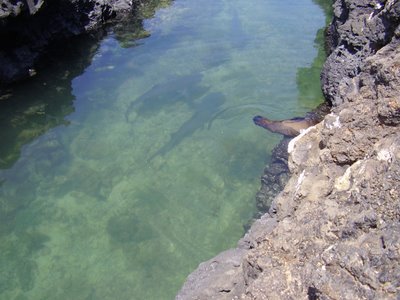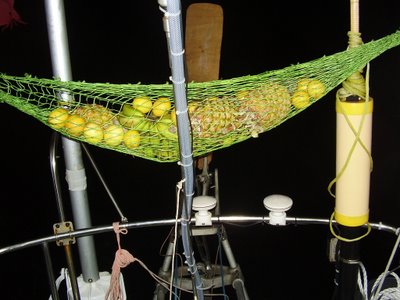We've left the Galapagos islands bound for the Marquesas, 2901 nautical miles away. It's our longest passage to date and will probably be the longest passage of the whole trip. It's daunting to look at the empty ocean ahead of us on our chart, but we feel far more aware of what we're undertaking than when we left the Canaries for the Caribbean and the end prize of the South Pacific Islands are worth the occasional hardship.
We left at 4.30pm Monday to the blast of fog horns from fellow sailors in the anchorage. Our five days there were mainly spent enjoying the unique wildlife, with a little boat preparation slotted in. As ever the wildlife was stunning; not far from the anchorage we saw white tip sharks circling in a pool and marooning a baby seal, until its mother arrived and dispersed the sharks by biting their tails.
The volcanic rocks around the shore were home to 1000s of marine iguanas, blue footed boobies and Galapagos penguins - amazing considering we were within 60 miles of the equator. We were also treated by the occasionally turtle swimming through the anchorage. An hour after leaving we saw two large dorsal fins looming out of the waves close the boat, which we decided must be a couple of large sharks. It feels as though we've been granted a privileged peek into the wildlife of the Galapagos, and although our time is up, we'd happily return again.
It seems that the start of a passage on Kika wouldn't be complete without a perplexing wind-vane steering problem. When we left Isabela we had 10knots of wind from the SE and initially headed SSW to clear the island. George the wind-vane had been expertly steering on fine-reaches such as this on our way to the Galapagos (once we'd corrected my reassembly error) so we couldn't understand why we were yawing from dead into the wind to broad-reach (120 degrees), under his control. For once I hadn't tampered with the steering, so we struggled to understand what had changed. The prospect of 2901 miles without working wind-vane steering wasn't appealing. My first plan of a liberal application of oil made little difference. Then pondering the problem it appeared that the wind wasn't strong enough to move the vane back vertical once it had been blown over. However 10 knots of wind should easily be sufficient so I reasoned that the problem must lie with the vane. I'd taken it off and tied it to the cockpit coaming; perhaps it had soaked up water during a washing frenzy, making the vane too heavy.
Pleased with my diagnosis I set about locating and then cutting our spare plywood into a rough vane shape in the now dark cockpit, convinced that this would provide the answer. Half an hour later it was clear that the new vane suffered the same problem as the old one. What had changed? I just couldn't work it out. Not until I was bashed on the head, while leaning over the stern to ponder the vane's erratic course, did I have my Newtonian flash of inspiration. The fruit net was so full of produce from the Galapagos that it was disrupting the flow of air to the vane. Moving the net higher up and clear of the air-flow solved the problem. Not exactly a gravity inventing knock to the head, but a eureka moment none-the-less.
-------------------------
Position @ 18:07 UTC: S02°05.0' W92°08.0'
Daily distance run: 83
Distance to go: 2818
Cumulative distance: 97
Engine hours:0.5
Wind: SE/S 10knots
Weather: lumpy sea, overcast, 1010 millibars
Subscribe to:
Post Comments (Atom)




No comments:
Post a Comment